| |
Summary:
April 2011 began with a surprising display
of auroras, prompted by an unexpected by geoeffective solar wind
stream. See also March 2011. |
|
 |
| |
| |
Photographer,
Location |
Images |
Comments |
|
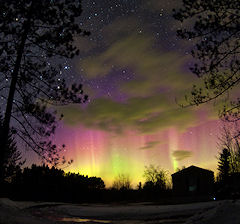
|
Brian
Larmay,
Pembine Wisconsin
Apr. 2, 2011 |
#1,
more |
It
has been a very long time since the aurora has come down
to my latitude. Finally the dry spell is over! Although
dim, the lights had shown up rather well on the dslr. Substorming
began shortly before 20:00 CST and lasted for about 15 mins
Photo info: Canon 40D Modified Exposure: 30 secs ISO 1600
Lens: Zenitar 16mm |
|
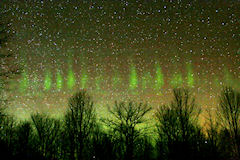 [movie!]
[movie!]
|
Jeff
Koch,
Paynesville, MI
Apr. 2, 2011 |
#1, #2,
#3, #4 |
Not
very bright, but the first ones we've seen in a long time!
We're glad they're back! Canon 30D 1600 ISO 30 sec 2230
EST. Auto Image in Photoshop to bring out the color. |
|
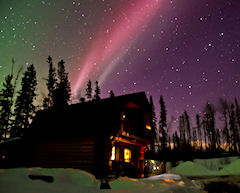
|
Steve
Milner,
30 km north of Ft St John, British Columbia, Canada.
Apr. 2, 2011 |
#1,
#2 |
This
is a first for me after 7 years of photographing northern
lights,these were taken just after midnight April 2nd/11
,I was checking out the Spaceweather site and saw the the
index was at 9 so I went outside and this band was stretching
across the entire sky in the opposite direction that I usually
see the auroras ,the band appeared to be whitest to the
naked eye so after my first shot well I was amazed ,could
I have set something different with the camera ,,so I took
a few more photos and yep they were red,,,,taken at were
we live with a Nikon D7000,2000 ISO,F3.5,with a 20 second
exposure,,,I can't wait for the next show ... |
|
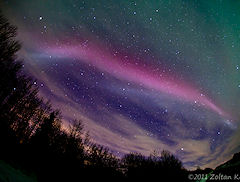
|
Zoltan
Kenwell,
North of Edmonton, Alberta, Canada
Apr. 2, 2011 |
#1,
#2, #3,
#4, more |
April
2nd had a very subdued but bright display. There were no
real defined bands in the auroras just a smooth green and
purple waves. I was able to shoot till 6:00am! The sky eventually
became too bright and the auroras faded into the blueness
of the pre-sunrise light. Just before it got too bright
to see the auroras, the sky went crazy. The auroras began
to pulse in very fast waves. If you can imagine the sound
pressure buffeting through a rolled down wind of a car on
the highway. That’s what the randomness and speed of the
aurora looked like. A perfect way to end and all-nighter
of capturing the beautiful aurora! Canon 5D mark II and
the EF 24mm f1.4 and the EF15mm Fisheye. ISO 1250, 3-30
seconds |
|
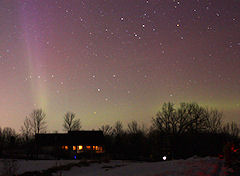
|
Rodirgo
Roesch,
Denmark, WI
Apr. 2, 2011 |
#1, #2
|
Auroras
showed up for about 10 min. Green columns of light appeared
and moved from one area to the other. I was lucky because
was exactly during the Neville Public Museum Astronomical
society Messier marathon. Canon Xsi, 17-40mm L series lens.
30s F4 ISO 400. |
|
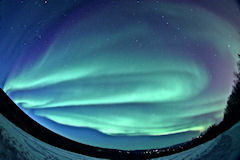
|
Warren Gammel,
Henderson Road, Fairbanks, Alaska
Apr. 1, 2011 |
#1, #2,
#3, #4 |
The lights came out really early tonight and I caught the tail end of the show at 11 p.m. I wished I would have headed out a little earlier at 10 or 10:30. After that, I took a nap in the truck and woke up to green clouds. Photos taken using Canon 7D with Tokina 11-16mm lens and Canon T1i with Peleng 8mm fisheye.
|
|
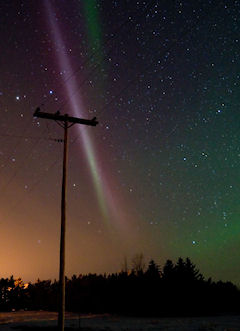
|
Sergio
Batista,
Indian Head, Saskatchewan, Canada
Apr. 1, 2011 |
#1, #2 |
After
another night of photography with Greg, Todd and James we
were surprised by these gorgeous colors floating above the
Town of Indian Head, Saskatchewan. Pictures taken with Sony
A55V and 550, ISO 1600 with exposures between 20 to 30 seconds.
|
|
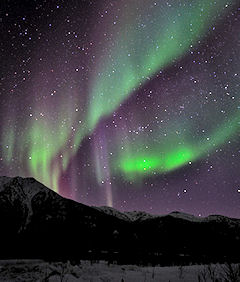
|
Wayne
Barsky,
About 15 miles north of Coldfoot, Alaska, on the middle fork
of the Koyokuk River.
Apr. 2, 2011 |
#1 |
Nikon
D7000, ISO 800, Tokina 11-16, F. 2.8, 25 seconds This was
a non-stop show from midnight until the sky started to brighten
around 4:30 am. It was a moonless and bitterly cold night
(-23 Fahrenheit). The deep violet and purple tones in the
photo were not visible to the eye, and this photo was chosen
because of those unusual colors. The photo was adjusted
only by bringing up the shadows a little -- that's it. While
waiting for my in-camera noise reduction process to complete,
I was watching what I thought was a satellite making a transit
from east to west across the sky when it suddenly flared
far more brightly than any other star in sky, then dimmed,
and ultimately disappeared. I assume I was lucky enough
to see the Space Plane (but not lucky enough to get it on
camera). |
 |
more
images: from
Jon Sigurdsson of Þingeyri, northwest of Iceland; from
Brandon Lovett of Fairbanks, Alaska; from
Kasper Solberg of Faroe Islands (Between Denmark and Iceland);
from
Neva Andersen north of St. Cloud, Minnesota;
|
|
|

|